Sushi Nakazawa – New York, NY
- the_maestro
- Oct 9, 2021
- 8 min read
Sushi omakase meals are a dime a dozen in New York City (or, perhaps more accurately, three grand a dozen). The super-high-end sushi experience has come to dominate the city’s Japanese cuisine scene, often frequented by, as the Maestro has written about before, the “Sushi Bro,” a flexing crowd of 20-some white dudes working for hedge funds that like to flash their cash at the city’s most expensive sushi parlor. “That tuna is epic, brah.”
Sushi Nakazawa is a breath of fresh air in a city where high-end omakase experience rap on the door of or exceed the $300 mark before beverages. Apart from the very most premium ingredients, diners can enjoy a sprawling and spectacular sushi omakase at this sleek counter for an even $150, for lunch or dinner. By no means a cheap meal, but one that pales in comparison to the breathtaking credit card indents that result from meals at Noz, Noda, or worse, Masa. Daisuke Nakazawa is a congenial dude who rose to fame working for the iconic Jiro of Jiro Dream of Sushi renown. He has showed remarkable resilience in keeping his prices approachable while never compromising on quality, luxury ingredients, or number of bites. It is, bar none, one of the best sushi deals in the city, if not in the country.
My friend Tamara, a fellow conducting grad from the University of Texas, happened to be in New York City during the same 24 hours I planned to be there, and invited me to attend opening weekend of the Met Opera’s first new production since the pandemic shuttered Lincoln Center––a staging of Terence Blanchard’s Fire shut up in my bones, the first opera staged by the Met written by a Black composer. A historic moment, and one I couldn’t pass up. Tamara, knowing my penchant for finding the best food, tasked me with finding spots for lunch and dinner, wanting to go “balls to the wall” to experience the best of NYC (wise!). The reservation search happened late, as is my want, so I had waitlist notifications primed for four different spots, including Nakazawa, which offered us seats first.

It was a late lunch reservation, but I was glad of the time after the flight from Boston to wash the cabin-in-the-Maine-woods-without-a-shower grime off and get dressed up for the Met. We took the subway to the West Village and entered the sleek, almost Men in Black-like space and took our seats at the sushi bar. I added the three supplements available, caviar, uni “tasting,” and A5 wagyu nigiri, and we watched the show already in progress for the half dozen diners seated for earlier reservations.


Champagne and caviar are natural pairings, and blanc de noirs is my go-to constitution of Champagne. From Moutard, this blanc de noirs was 100% pinot noir, so it had the characteristic roundness, but, being a “brut nature,” it had almost no residual sugar, which gave it a grippy dryness and tang. A very interesting manifestation of blanc de noirs, and of course ideal with the healthy mound of golden osetra caviar perched atop sushi rice and a hint of crispy nori, as well as a few flakes of pretty, but perennially unnecessary, edible gold leaf.


Our sushi chef was warm and crafted each the pieces perfectly, and also happened to be the very first woman I’ve ever seen manning (womaning?) a sushi counter! Tamara, also inhabiting a career that is dominated by men, was thrilled, and engaged her in conversation about what it’s like being a woman in this profession. Turns out, she came from Osaka after completing culinary school in Japan because she wanted to be a sushi chef and hadn’t a prayer in a country where the other side of the sushi counter is still very much considered a man’s domain. In New York, the exploding sushi scene meant she had a much better shot at a job, and now is one of the assistants to Daisuke-san at one of the best sushi restaurants in America. Great story!

Two pieces of salmon came first––the first was a pale, delicate Japanese salmon dressed with sudachi, a Japanese citrus, and very fine sea salt. Delicate and supple, and probably the first time I’ve sampled a salmon from Japan. The second was the classic––ora king salmon from New Zealand that was lightly torched to let some of the succulent fat render. Decadent as always, and the first piece that got Tamara, who had never experienced a sushi omakase like this, absolutely hooked.


The Champagne was gone, so it was time for sake! I told my beverage server I wanted a progression of three glasses of his choosing. He started with Manzairaku Yamahai Junmai from Ishikawa Prefecture. The rice for this sake is harvested a month later than normal, and the temperature change in that last month of growing stimulates more starch production in the rice. This gives this sake's signature umami, with a dry richness that almost tastes like a vanilla mushroom, but still with lively acidity characteristic of a Yamahai. A great way to start!

Shellfish (mostly) comprised the next four bites. First was a delicate, toothsome scallop with a pleasantly surprising yuzu kosho hidden beneath. Sea-sweet and pristine, it was the perfect scallop, though the yuzu kosho was a little dominant and the lingering spice made it difficult to appreciate any kind of lingering scallop flavor. Next was squid atop a shiso leaf and topped with a red miso condiment. Vegetal, slightly crunchy, and rounded out by a bomb of umami achieved by a mere drop of the miso condiment. My favorite of the “shellfish.” A square-style of sushi, described by the sushi chef as a particular tradition but lost in translation, was topped with king crab and a funky sauce made of “crab innards.” Last, and least remarkably, was a giant tiger prawn from Japan, which was just OK and to my mind stood in for what could be a sampling of the tail end of spot prawn season.
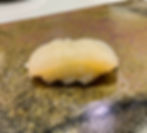
Some whitefish next––first, hirame, or fluke, similar to halibut, flavored with just a dusting of yuzu zest. Fresh and bright, but could have used a shade more yuzu to my mind. Next was kinmedai, goldeneye snapper, one of my favorite fish, torched just briefly on the skin and topped with some flaky sea salt. Tamara’s favorite piece at this point in the meal.

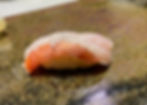
With the flavors of the fish soon moving into bolder territory, it was time for the next in the sake progression. The bodaimoto method of sake production is one of the three "ancient" methods, like the yamahai method of the previous glass. Developed by monks in Nara in the 14th century, this method involves soaking the rice in water for several days, which stimulates the growth of microbes that these monks noticed prevented spoilage. The resulting sake is complex, funky, and viscous. This sake, from Takacho in the Nara Prefecture, uses part raw rice and part soaked rice, giving it a thick citrus yogurt profile adorned by cherries and even a little bit of meaty umami. Such a cool sake!

Two members of the “mackerel” clan were up next, though only one of them––a Spanish mackerel smoked in hay from the North Carolina (!) coast––was a proper mackerel. The other, aji, is called “horse mackerel” but is better described as a member of the jack family. Firm flesh, strong in flavor, and topped with a tiny dollop of ginger, it was a classic preparation of aji.
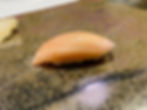

Two more jacks followed, these two with slightly firmer flesh and simply prepared with shoyu. Shima aji, striped jack, the professed favorite of our sushi chef, was exquisite and had a slight marbling, while the kanpachi, amberjack, had a bit more bite and robust flavor. Two of the best examples of these ubiquitous fish I’ve had.

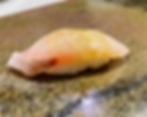
I was flabbergasted by how complete the omakase was so far––most places that serve omakase meals well below the "going rate" either skimp on quality or quantity, and certainly both were being maintained (and then some!) at this lunch. I knew that things were accelerating into stronger flavors once the first piece of tuna showed up. This nuanced, pale pink-orange tuna was yellowfin from Japan, by far the more sustainable of the tuna selections, and one that I am learning to appreciate in its own rite. Bluefin, of course, was also on offer, and a mineral-tinged akami (lean), perfectly balanced chutoro (medium-fatty belly), and decadent otoro (fatty belly) were served in a set of three, from right to left. The chutoro is my favorite of the bluefin cuts because it’s not just fat––it showcases both the strong iron minerality of the lean bluefin flesh and the fatty goodness of the tuna belly. Knockout, though I don’t know if much (besides time saving) was accomplished by presenting all three simultaneously––I prefer to consider each piece as it comes.
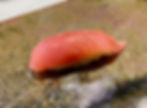
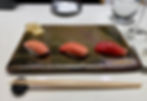
Time for roe. So, time for the most aggressive and unusual of the three sake glasses. From Kyoto, this sake is called "Time Machine 1712" because it uses a sake recipe from––you guessed it––the year 1712. No clean, clear ginjo styles here––the slightly sweet, honeyed sake has three to seven times the levels of aminos in contemporary sakes, and sang with depth, musk, aged fruit, and even soy-like umami. This man does his job well, and was giving me a real education in unusual, historic sake styles

First, ikura in a perfectly crispy rolled nori, was mouthwateringly salty. I am beginning to really appreciate salmon roe. Next, uni from Hokkaido, which y’all know I loved, and Tamara ended up really loving as well. This particular tray of uni had a bit more assertive flavor than I’m used to from Japanese urchins, and the perfectly crisp nori was a welcome texture contrast. Finally, my “uni tasting” was an extra-special uni from northeastern Hokkaido, generously spooned over sushi rice and topped with fresh wasabi. Much more nuanced and delicate than the first urchin, and possibly the best sea urchin I’ve had the chance to try. Tamara giggled at the look of sheer bliss on my face and the noises of joy as I took tiny bites to make it last as long as possible.



Finally, nearly two hours after arriving. we’d entered the last phase of the savory nigiri. A5 wagyu beef was torched and topped with an umami-laden condiment that got lost in language barrier, but was exquisite, and Tamara’s first experience with Japanese A5. She was decidedly not disappointed. Finally, a toro hand roll rounded out the savory sushi, with the saline crunch of the nori, wrapped only seconds before it hit my tongue (as it should be) enclosing a spare center of mashed bluefin belly. Fantastic.
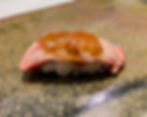
Of course, you close sushi meals with anago, or sea eel, and tamago, Japanese egg custard. The eel was fine but nothing remarkable while the tamago had a magnificent balance between creamy sweet and briny, though was a shade on the dry side for my liking, though tamago varies widely and preferences are intensely personal! Last but not least, a rice custard with crisp crème brûlée top. Perfect.
I don’t think there is anything that can compare to a magnificent sushi omakase meal. It is my very favorite thing in all the world, and walking around Washington Square Park, I was still bathing in the afterglow of anther spectacular sushi meal (and three glasses of sake… and also the now-ubiquitous ambient marijuana smoke around the fountain). Tamara was blown away by the experience, calling it “the stuff of movies,”––I think I may have a convert on my hands!

We ended the meal way too close to our dinner reservation at Atoboy. Walking back up to East 28th Street through the NYU area helped re-stir up my appetite, and I certainly enjoyed what was one of my most anticipated meals in a while. Stay tuned for that review!











